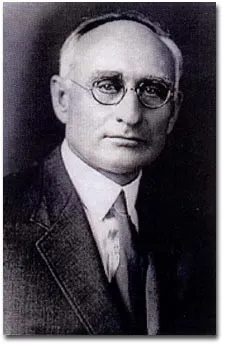Andrew Ernest Morgan: Controller of Water, Mover of Men

Part One
Most of us probably do not even recognize the name of Arthur Ernest Morgan; yet for those of us living in the the rural communities of the Tennessee Valley, Morgan should be remembered every time we switch on our lights or plug in our computers. Arthur Morgan was the first Director of the Tennessee Valley Authority, but he was much more than just a political appointee or bureaucratic figurehead. Morgan, a civil engineer, was an expert in water flow and water control. He was a hands on director who busied himself with the most intimate parts of the TVA: the inner workings of the dams and the communities they served. As an engineer, he designed the dams, made the earth move, mined the rock, and poured the concrete. As a visionary, he designed communities with energy efficient housing and environmental consideration. As an educator, Morgan saw the need to teach the people to use better farming practices and to train people to use electricity to make their daily chores easier.
It seems water was a part of Morgan's life from his birth in 1878 near Hope Avenue and just uphill from River Road, a few miles downstream from Cincinnati. His father moved the family north to St. Cloud, Minnesota near the Mississippi River where Arthur overcame a dire case of meningitis and measles. But disease was not his only foe. Growing up the son of a pious mother and a drunken father pulled him into continuous bouts of raging arguments. His first discipline became the control of his temper, a quality that would serve him well as he wrestled with the future struggles of political patronage. Feeling he had learned what he could in St. Cloud, Morgan floated down the Mississippi River some thirty miles on a three-foot-wide log to find a job in Anoka.
However the lack of work in the town of Anoka only convinced him to go west. Colorado seemed the likely frontier and offered a variety of jobs along the way. He picked fruit. He set type. He delivered goods. He mined coal. He even bought fifty 30-cent editions of Ruskin, Carlyle, Goethe, Emerson and Kipling and tried selling them to miners with no success. But none of these jobs satisfied his primary objective. Morgan wanted a job that in its essential character was a contribution to human well-being. In the Rockies of Colorado, he learned that he liked working outdoors in a lumber camp. But he could not continue to work for a company that cut lumber to build gambling halls. His ethics were developing along with his skills. Without a job, he decided to take some courses at the University of Colorado. But his poor eyesight and his lack of income limited his educational pursuits.
So as with many an adventurous youth, Morgan returned home to find his father had become a respected surveyor and owned his own business. He joined his father and together they developed Morgan & Morgan. Building on his love for the outdoors and his practical sense of skill, Arthur decided to specialize in water control. Water control was a new field, one he could learn without undue competition. Minnesota offered many opportunities to work with water from numerous natural lakes to the Mississippi River. At twenty-six years old, Morgan volunteered for the job that would sew the first seed of his future resume'. In 1904, he offered to write the drainage control standards for the state of Minnesota. When the state legislature adopted the proposed standards into law, the Governor of Minnesota offered Morgan the job of State Engineer.
But Arthur Morgan chose another route. He took a national test and became one of four engineers hired by the United States Department of Agriculture's Office of Drainage Investigation. Morgan had launched his national career. But tragedy would strike and cause him to second think his career choice.
- Log in to post comments